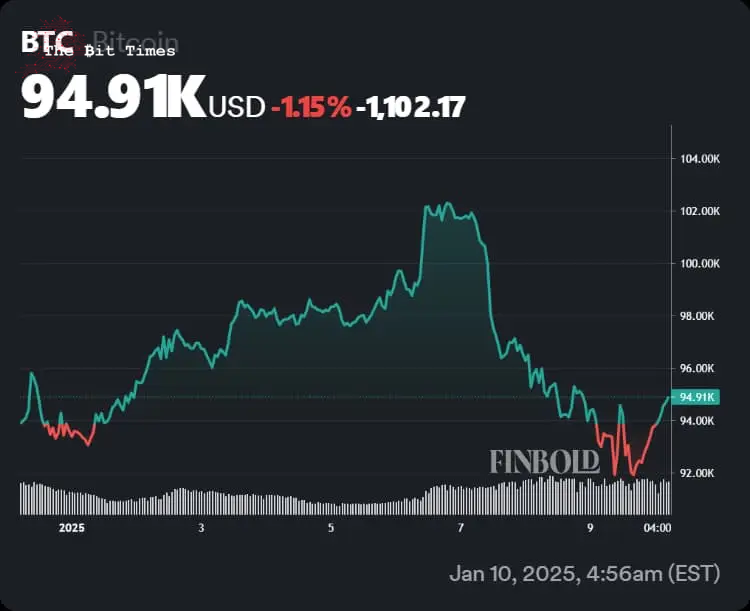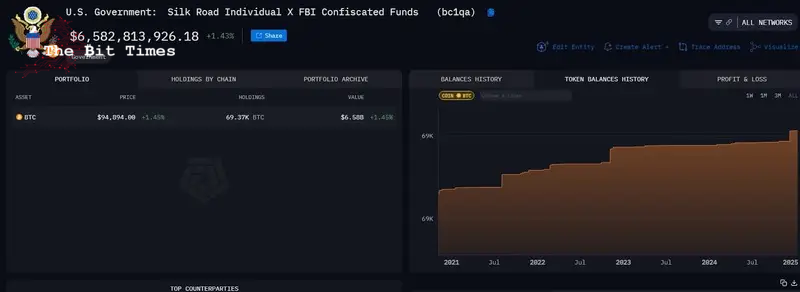Are traders heavily shorting Bitcoin?
As is frequently the case whenever assets such as Bitcoin (BTC) trade uncharacteristically highs or experience a rapid plunge, many investors turn to their short ratios to try and gauge the overall market sentiment and detect possible causation.
The world’s premier cryptocurrency is in such a situation at press time on January 10 as it has been trading with significant volatility in recent weeks and has, so far, failed to find a stable footing above the critical psychological level above $100,000 in 2025.
Most recent data from the world’s largest cryptocurrency exchange by trading volume, Binance, however, reveals that the sentiment might again be turning bullish as the proportion of long BTC positions has been rapidly increasing in the second half of the January 6 to January 12 week.
Picks for you
Is Bitcoin heavily shorted today?
Specifically, the number of bets against Bitcoin peaked on January 7 – simultaneously with the coin’s recent price peak at about $101,000 – when as many as 56.76% of accounts were in a short position against the digital asset.
By press time, the percentages shifted significantly in favor of bullish bets, with as many as 68.28% of top Binance accounts taking a long position by January 10, signaling a general expectation BTC will rally at least for some time.

The change in attitude was accompanied by a marked shift in the coin’s price performance, which, after finding its latest bottom just under $92,000, rallied to its press time price of $94,914.

Are investors accumulating or selling Bitcoin?
Still, the latest available data covering ‘buy’ and ‘sell’ volumes shows that more accounts are selling Bitcoin than buying. However, it is not certain if it is profit-taking behavior or a loss of faith in a continued 2025 rally.
On the other hand, it is noteworthy that the most recent available figures are for January 9, meaning they do not reflect the volume that helped BTC regain some ground after collapsing below $92,000 on Thursday.

Why Bitcoin’s rally might persist
Furthermore, the shift in sentiment observable at press time can be traced to a combination of factors. To begin with, recent trading was plagued by the reminder that the Department of Justice is still free to sell $6.5 billion worth of Bitcoin it seized from the illicit Silk Road market.
Though knowledge that such government actions are in the cards tends to have an impact on the market, the actual offloading of cryptocurrency by law enforcement is seldom impactful, as Finbold reported on January 9.
Additionally, it is likely the DoJ will not have a negative impact on Bitcoin’s price after the initial shock passed, especially since on-chain data retrieved on January 10 from Arkham reveals no BTC has been moved thus far.

As for the coin’s likely next move, the recent positive momentum is likely to send it higher and toward $99,000, with the prominent blockchain expert Ali Martinez opining on X that BTC is poised for a rebound now that it enjoyed an hourly close above $94,700.
Is this the next most important price for Bitcoin?
Still, given the recent trading, the true test will come once Bitcoin reaches $97,000 – a value that has proved an important psychological resistance in recent trading – with the strength of the upward move after reaching that level likely determining future direction.
A possible bearish reading for BTC would be that it is repeating a similar pattern to the summer of 2024. Indeed, despite optimism persisting for most of last year, Bitcoin experienced several months of decline as it began recording a series of lower highs and lower lows.
Though such a pattern is not yet guaranteed, the last 30 days did feature a rally above $108,000 followed by a plunge below $95,000 and a rally above $99,000 followed by a decline below $93,000.
While the subsequent January 7 high was higher at about $101,000, the next low – the one recorded on January 9 – was lower as it threatened a drop all the way to $91,000.
Could this external catalyst make Bitcoin go parabolic?
Finally, whether the loose late 2024 and early 2025 pattern is confirmed or not, there is a strong possibility it will be invalidated by a powerful external catalyst before the end of the month.
Specifically, Donald Trump’s re-election in November was the event that arguably ended the long summertime decline and propelled BTC to new all-time highs (ATH). There is a strong possibility that the markets will react with similar enthusiasm when the Republican officially takes the helm with the January 20 inauguration.
Featured image via Shutterstock
Comments
Post a Comment